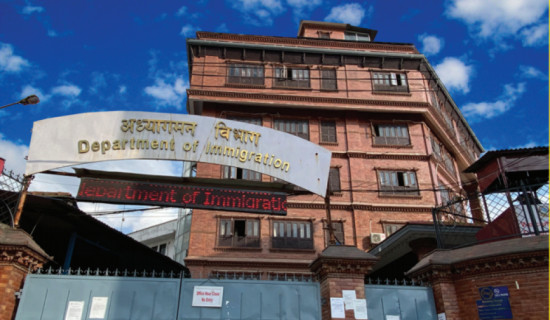- Tuesday, 30 December 2025
Tackle Overcrowding In Prisons
Prison management has been a serious challenge in Nepal owing to, inter alia, overcrowding. There are 74 prisons all over the country. As the number of offenders is growing day by day, these prisons have turned out to be inadequate. As such, there is a compulsion to detain prisoners in cramped cells. There are two child correction centres for juvenile offenders in the Kathmandu Valley. These centres are operated by non-governmental organisations with funding from the government. There are no prisons for female offenders; they are kept in separate blocks within the general prisons.
The Department of Prison Management, under the Ministry of Home Affairs, is responsible for policy formation, and administration and management of prisons. At the local level, chief district officers are responsible for prison management. However, there are problems galore with prison management. The infrastructure is not only inadequate but also poor. Most of the prison buildings are dilapidated. The facilities, such as toilets, washing space and exercise space, are insufficient. Owing to congestion, the prisoners are compelled to languish in cramped cells. All these have a negative impact on not only the prisoners but also the jailors and other staff.
Prison Act
In Nepal, the first prison – the Central Jail – was established in Kathmandu in 1914 AD. The prison was under the supervision of the Mukhiya and the Chief Rana General. After the dawn of democracy in 1951, the jail was placed under the Home Ministry. In 1963, the Prison Act was enacted, with the Prison Rules coming out in 1964. Four years after the reinstatement of multi-party democracy, the Department of Prison Management was set up. Now, prison management is governed under the Prison Act, 2019.
Prisoners are also human beings. They should, therefore, be fairly treated. According to the United Nations Standard Minimum Rules for the Treatment of Prisoners (Nelson Mandela Rules), 2015, prisoners should be treated with respect and dignity. Prisoners also have human rights, which need to be protected. Further, they should be protected from violence, torture and other cruel, inhuman or degrading treatment. Likewise, the Geneva Conventions have a provision of protecting civilians in armed conflict and fairly treating prisoners of war.
Prisons should not be considered mere detention centres. They should be taken as houses of reform, where prisoners’ behaviour can be reformed. Likewise, prisoners should not be perceived to be perpetual offenders. They should be given a chance to reintegrate themselves into society. Almost no person wants to commit a crime. There may be social, economic, familial and other motives behind committing crimes. The perception about prisons has now changed. Reform, rehabilitation and reintegration into society should be the motive behind prison management.
There are several challenges for the management of prisons, one of them being overcrowding. Overcrowding violates prisoners’ legal and constitutional rights. Overcrowding is one of the main problems associated with prisons in both developed and developing countries. There were 29,484 prisoners, including pre-trial detainees/remand prisoners, in February 2025 in Nepal (World Prison Brief). Overcrowding deprives prisoners of the facilities they are entitled to. Overcrowding gives rise to various problems, such as deteriorating conditions of health and living, financing and effective rehabilitation and reintegration into society. When prisoners are compelled to languish in a harsh environment, they carry the ordeals they have experienced in prison to their outside world after release.
As such, they cannot easily adjust their life to normal life after release. Further, during pandemics like COVID-19, overcrowding is likely to spread diseases quickly among prisoners. That is why it has been imperative to address the problem of overcrowding. To mitigate overcrowding in prisons, there are several measures that can be taken. Building additional prisons or expanding the existing prisons could be one of the solutions. However, this entails an additional budget. Early release from prison could be another option. It may be noted that during special occasions such as Republic Day and Constitution Day, some prisoners who have served much of their sentence and who have shown good conduct are released.
But sometimes this could engender controversy. Even prisoners whose offences are unpardonable may be released or those who have been released for their good conduct may relapse into crime. Further, political influence may be the deciding factor behind the early release of prisoners. The parole system is another option for mitigating overcrowding in prisons. According to the system, prisoners are conditionally released to serve the remaining sentence in the community. Parole, an alternative mode of punishment, is a privilege granted to prisoners to get assimilated into society again so that they do not perpetrate any new crime.
Overcrowding
The Criminal Offences Sentencing and Execution Act, 2017, allows community service for certain offenders. So the act seems a bit progressive. Other measures that can be adopted to reduce overcrowding in prisons are the provision of suspended sentences, probation and the open prison system. The Nuwakot Open Prison came into operation in September 2024 with the transfer of 48 prisoners from the Nuwakot District Prison. The modern prison is the first of its kind in the country. It has a capacity of 1,370 inmates. Inmates from the Central Jail, Nakkhu Jail and Dillibazaar Jail have been relocated to the prison.
The open prison is aimed at reducing overcrowding in other prisons, providing comfortable space for prisoners for living, physical activity, recreation and other activities, promoting rehabilitation, allowing community work for employment and so on. The open prison is far better than the closed prison system in that it provides prisoners with more freedom and creates an enabling environment of living more comfortably so that they do not have to languish. The long-term vision of the prison is to develop it into a modern, industrial prison. So such a prison system needs to be replicated in other districts of the country as well.
(Maharjan has been regularly writing on contemporary issues for this daily since 2000.)




-square-thumb.jpg)
-square-thumb.jpg)









-original-thumb.jpg)

